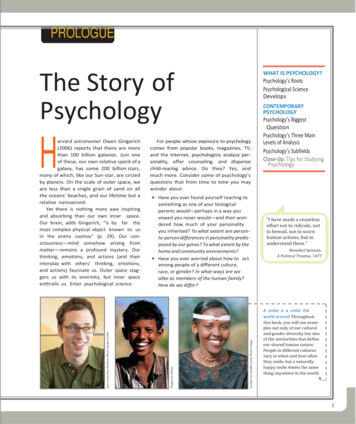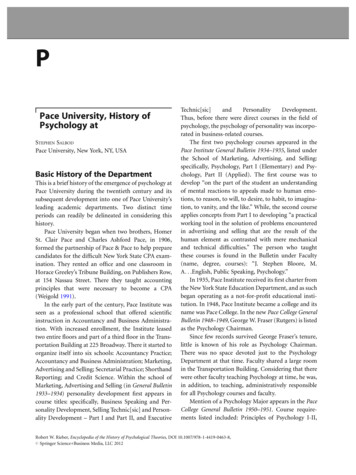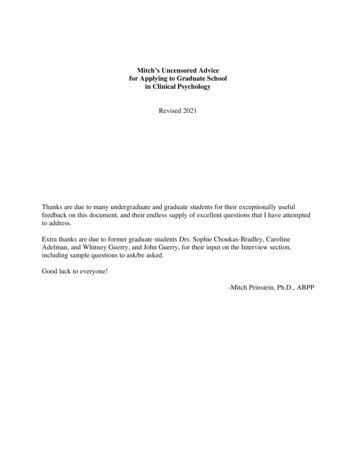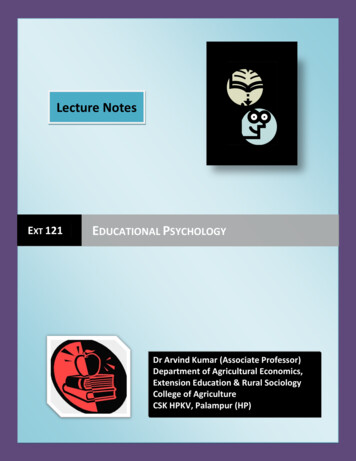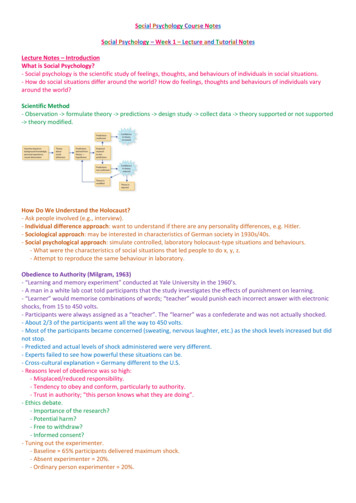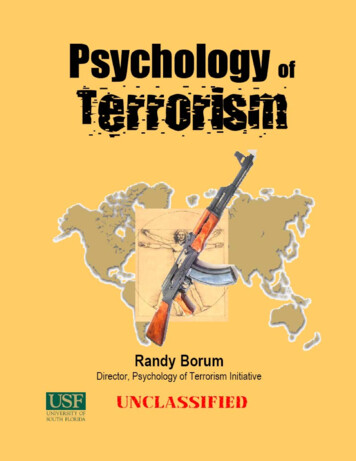
Transcription
MethodologyWe have defined terrorism here as “acts of violence intentionally perpetrated on civilian noncombatants with the goal of furthering some ideological, religious or political objective.” Ourprincipal focus is on non-state actors.Our task was to identify and analyze the scientific and professional social science literaturepertaining to the psychological and/or behavioral dimensions of terrorist behavior (not onvictimization or effects). Our objectives were to explore what questions pertaining to terroristgroups and behavior had been asked by social science researchers; to identify the mainfindings from that research; and attempt to distill and summarize them within a framework ofoperationally relevant questions.Search StrategyTo identify the relevant social science literature, we began by searching a series of major academic databasesusing a systematic, iterative keyword strategy, mapping, where possible onto existing subject headings. Thefocus was on locating professional social science literature published in major books or in peer-reviewed journals.The following database searches were conducted in October, 2003. Sociofile/Sociological AbstractsCriminal Justice Abstracts (CJ Abstracts)Criminal Justice Periodical Index (CJPI)National Criminal Justice Reference Service Abstracts (NCJRS)PsychInfoMedlinePublic Affairs Information Service (PAIS)The “hit count” from those searches is summarized in the table below. After the initial list wasgenerated, we cross-checked the citations against the reference list of several major reviewworks that had been published in the preceding five years (e.g., Rex Hudson’s “The Psychologyand Sociology of Terrorism”i) and included potentially relevant references that were not alreadyon the list. Finally, the list was submitted to the three senior academic consultants on theproject: Dr. Martha Crenshaw, Dr. John Horgan, and Dr. Andrew Silke solicitingrecommendations based only on relevance (not merit) as to whether any of the citations listedshould be removed and whether they knew of others that met the criteria that should be added.Reviews mainly suggested additions (rarely recommending removal) to the list. Revisions weremade in response to reviewer comments, and the remaining comprised our final citation list.AnnotationsThree types of annotations are provided for works in this bibliography:Author’s Abstract: This is the abstract of the work as provided (and often published)by the author. If available, it is provided even if another annotation also is included.Editor’s Annotation: This is an annotation written by the Editor of this bibliography.Key Quote Summary: This is an annotation composed of “key quotes” from the originalwork, edited to provide a cogent overview of its main points.
Psych InfoMedlineCJPINCJRSTerrorismCJ AbstractsPAISSocioFile10 (0)2 (0)50Terror* (kw)844Terror* (kw) & Mindset1 (0)1353N/A04(0)Boolean 33 (0)N/A2115Terror* (kw) & Psych* (kw) N/A428141N/AN/ATerrorism and MindsetN/AN/AN/AN/A1N/AN/APsychology(Sub) &Terror*(kw)5017 (0)N/AN/AN/AN/AN/APsychology(Sub) &Terrorism (Sub)3511 (0)N/AN/AN/AN/AN/APsychology & TerrorismN/AN/AN/ABoolean 154 (0)142328Political Violence (kw)55764(0)89 (0)Boolean 1950N/AN/APolitical Violence (kw) &PsychologyN/AN/AN/AN/AN/A10 (0)149N/ANumbers Total resultsN/A Search Termunnecessary(0) No items were kept fromthe resultskw keywordProject Team Project Director:–Dr. Randy Borum – University of South Florida Senior Advisors:–Dr. Robert Fein – National Violence Prevention & Study Center / CIFA–Mr. Bryan Vossekuil – National Violence Prevention & Study Center / CIFA Senior Consultants:–Dr. Martha Crenshaw – Wesleyan University–Dr. John Horgan – University College at Cork–Dr. Andrew Silke – UK Home Office–Dr. Michael Gelles – Naval Criminal Investigative Service–Dr. Scott Shumate – Counterintelligence Field Activity (CIFA) CENTRA–Lee Zinser – Vice President–Bonnie Coe – Senior Analyst
Reference List1. Root causes of terrorism. International expert meeting in Olso Olso: Norwegian Institute of InternationalAffairs.Call Number: Key Quote Summary: An international panel of leading experts on terrorism met inOslo to discuss root causes of terrorism. The main purpose was to provide inputs from the researchcommunity to a high-level conference on “Fighting Terrorism for Humanity” to be held in NewYork on 22 September 2003. The findings described below are conclusions drawn by the chairmanon the basis of presentations and discussions.-A main accomplishment of the expert panel was to invalidate several widely held ideas about whatcauses terrorism. There was broad agreement that there is only a weak and indirect relationshipbetween poverty and terrorism. At the individual level, terrorists are generally not drawn from thepoorest segments of their societies. Typically, they are at average or over-average levels in terms ofeducation and socio-economic background. Poor people are more likely to take part in simpler formsof political violence than terrorism, such as riots. The level of terrorism is not particularly high in thepoorest countries of the world. Terrorism is more commonly associated with countries with amedium level of economic development, often emerging in societies characterized by rapidmodernization and transition. On the other hand, poverty has frequently been used as justification forsocial revolutionary terrorists, who may claim to represent the poor and marginalized without beingpoor themselves. Although not a root cause of terrorism, poverty is a social evil that should befought for its own reasons.- State sponsorship is not a root cause of terrorism. Used as an instrument in their foreign policies,some states have capitalized on pre-existing terrorist groups rather than creating them. Terroristgroups have often been the initiators of these relationships, at times courting several potential statesponsors in order to enhance their own independence. State sponsorship is clearly an enabling factorof terrorism, giving terrorist groups a far greater capacity and lethality than they would have had ontheir own. States have exercised varying degrees of control over the groups they have sponsored,ranging from using terrorists as “guns for hire” to having virtually no influence at all over theiroperations. Tight state control is rare. Also Western democratic governments have occasionallysupported terrorist organizations as a foreign policy means.- Suicide terrorism is not caused by religion (or more specifically Islam) as such. Many suicideterrorists around the world are secular, or belong to other religions than Islam. Suicide terrorists aremotivated mainly by political goals usually to end foreign occupation or domestic domination by adifferent ethnic group. Their “martyrdom” is, however, frequently legitimized and glorified withreference to religious ideas and values.- Terrorists are not insane or irrational actors. Symptoms of psychopathology are not commonamong terrorists. Neither do suicide terrorists, as individuals, possess the typical risk factors ofsuicide. There is no common personality profile that characterizes most terrorists, who appear to berelatively normal individuals. Terrorists may follow their own rationalities based on extremistideologies or particular terrorist logics, but they are not irrational.-What causes terrorism? The notion of terrorism is applied to a great diversity of groups withdifferent origins and goals. Terrorism occurs in wealthy countries as well as in poor countries, indemocracies as well as in authoritarian states. Thus, there exists no single root cause of terrorism, oreven a common set of causes. There are, however, a number of preconditions and precipitants for theemergence of various forms of terrorism.One limitation of the “root cause” approach is the underlying idea that terrorists are just passivepawns of the social, economic and psychological forces around them doing what these “causes”compel them to do. It is more useful to see terrorists as rational and intentional actors who developdeliberate strategies to achieve political objectives. They make their choices between differentoptions and tactics, on the basis of the limitations and possibilities of the situation. Terrorism isbetter understood as emerging from a process of interaction between different parties, than as amechanical cause-and-effect relationship.-With these reservations in mind, it is nevertheless useful to try to identify some conditions andcircumstances that give rise to terrorism, or that at least provide a fertile ground for radical groupswanting to use terrorist methods to achieve their objectives. One can distinguish betweenpreconditions and precipitants as two ends of a continuum.
-Preconditions set the stage for terrorism in the long run. They are of a relatively general andstructural nature, producing a wide range of social outcomes of which terrorism is only one.Preconditions alone are not sufficient to cause the outbreak of terrorism. Precipitants are much moredirectly affecting the emergence of terrorism. These are the specific events or situations thatimmediately precede, motivate or trigger the outbreak of terrorism. The first set of causes listedbelow have more character of being preconditions, whereas the latter causes are closer toprecipitants. (The following list is not all-inclusive.)- Lack of democracy, civil liberties and the rule of law is a precondition for many forms of domesticterrorism. The relationship between government coercion and political violence is essentially shapedlike an inverted U; the most democratic and the most totalitarian societies have the lowest levels ofoppositional violence. Moderate levels of coercive violence from the government tend to fuel the fireof dissent, while dissident activities can be brought down by governments willing to resort toextreme forces of coercive brutality. Such draconian force is beyond the limits of what democraticnations are willing to use and rightfully so.- Failed or weak states lack the capacity or will to exercise territorial control and maintain amonopoly of violence. This leaves a power vacuum that terrorist organizations may exploit tomaintain safe havens, training facilities and bases for launching terrorist operations. On the otherhand, terrorists may also find safe havens and carry out support functions in strong and stabledemocracies, due to the greater liberties that residents enjoy there.- Rapid modernization in the form of high economic growth has also been found to correlate stronglywith the emergence of ideological terrorism, but not with ethno-nationalist terrorism. This may beparticularly important in countries where sudden wealth (e.g. from oil) has precipitated a changefrom tribal to high-tech societies in one generation or less. When traditional norms and socialpatterns crumble or are made to seem irrelevant, new radical ideologies (sometimes based onreligion and/or nostalgia for a glorious past) may become attractive to certain segments of society.Modern society also facilitates terrorism by providing access to rapid transportation andcommunication, news media, weapons, etc.- Extremist ideologies of a secular or religious nature are at least an intermediate cause of terrorism,although people usually adopt such extremist ideologies as a consequence of more fundamentalpolitical or personal reasons. When these worldviews are adopted and applied in order to interpretsituations and guide action, they tend to take on a dynamics of their own, and may serve todehumanize the enemy and justify atrocities.- Historical antecedents of political violence, civil wars, revolutions, dictatorships or occupation maylower the threshold for acceptance of political violence and terrorism, and impede the developmentof non-violent norms among all segments of society. The victim role as well as longstandinghistorical injustices and grievances may be constructed to serve as justifications for terrorism. Whenyoung children are socialized into cultural value systems that celebrate martyrdom, revenge andhatred of other ethnic or national groups, this is likely to increase their readiness to support orcommit violent atrocities when they grow up.- Hegemony and inequality of power. When local or international powers possess an overwhelmingpower compared to oppositional groups, and the latter see no other realistic ways to forward theircause by normal political or military means, “asymmetrical warfare” can represent a temptingoption. Terrorism offers the possibility of achieving high political impact with limited means.- Illegitimate or corrupt governments frequently give rise to opposition that may turn to terroristmeans if other avenues are not seen as realistic options for replacing these regimes with a morecredible and legitimate government or a regime which represents the values and interests of theopposition movement.- Powerful external actors upholding illegitimate governments may be seen as an insurmountableobstacle to needed regime change. Such external support to illegitimate governments is frequentlyseen as foreign domination through puppet regimes serving the political and economic interests offoreign sponsors.- Repression by foreign occupation or by colonial powers has given rise to a great many nationalliberation movements that have sought recourse in terrorist tactics, guerrilla warfare, and otherpolitical means. Despite their use of terrorist methods, some liberation movements enjoyconsiderable support and legitimacy among their own constituencies, and sometimes also fromsegments of international public opinion.
- The experience of discrimination on the basis of ethnic or religious origin is the chief root cause ofethno-nationalist terrorism. When sizeable minorities are systematically deprived of their rights toequal social and economic opportunities, obstructed from expressing their cultural identities (e.g.forbidden to use their language or practice their religion), or excluded from political influence, thiscan give rise to secessionist movements that may turn to terrorism or other forms of violent struggle.Ethnic nationalisms are more likely to give rise to (and justify) terrorism than are moderate andinclusive civic nationalisms.- Failure or unwillingness by the state to integrate dissident groups or emerging social classes maylead to their alienation from the political system. Some groups are excluded because they hold viewsor represent political traditions considered irreconcilable with the basic values of the state. Largegroups of highly educated young people with few prospects of meaningful careers within a blockedsystem will tend to feel alienated and frustrated. Excluded groups are likely to search for alternativechannels through which to express and promote political influence and change. To some, terrorismcan seem the most effective and tempting option.- The experience of social injustice is a main motivating cause behind social revolutionary terrorism.Relative deprivation or great differences in income distribution (rather than absolute deprivation orpoverty) in a society have in some studies been found to correlate rather strongly with the emergenceof social revolutionary political violence and terrorism, but less with ethno-nationalist terrorism.- The presence of charismatic ideological leaders able to transform widespread grievances andfrustrations into a political agenda for violent struggle is a decisive factor behind the emergence of aterrorist movement or group. The existence of grievances alone is only a precondition: someone isneeded who can translate that into a programme for violent action.- Triggering events are the direct precipitators of terrorist acts. Such a trigger can be an outrageousact committed by the enemy, lost wars, massacres, contested elections, police brutality, or otherprovocative events that call for revenge or action. Even peace talks may trigger terrorist action byspoilers on both sides. Individuals join extremist groups for different reasons. Some are truebelievers who are motivated by ideology and political goals, whereas others get involved for selfishinterests, or because belonging to a strong group is important to their identity.-Factors sustaining terrorism:Terrorism is often sustained for reasons other than those which gavebirth to it in the first place. It is therefore not certain that terrorism will end even if the grievancesthat gave rise to it, or the root causes, are somehow dealt with. Terrorist groups may change purpose,goals and motivation over time.- Cycles of revenge: As a response to terrorist atrocities, reprisals are generally popular with broadsegments of the public. However, this tends to be the case on both sides, which often try to out doeach other in taking revenge to satisfy their respective constituencies. Deterrence does often notwork against non-state terrorist actors. Violent reprisals may even have the opposite effect ofdeterrence because many terrorist groups want to provoke over-reactions. Policies of militaryreprisal to terrorist actions may become an incentive to more terrorism, as uncompromising militantsseek to undermine moderation and political compromise.- The need of the group to provide for its members or for the survival of the group itself may alsocause a terrorist group to change its main objectives or to continue its struggle longer than itotherwise would have, e.g. to effect the release of imprisoned members or to sustain its memberseconomically.- Profitable criminal activities to finance their political and terrorist campaigns may eventually giveterrorist groups vested interests in continuing their actions long after they realise that their politicalcause is lost. Alternatively, some continue even if many of their political demands have been met.- No exit: With “blood on their hands” and having burnt all bridges back to mainstream society,some terrorist groups and individuals continue their underground struggle because the onlyalternative is long-term imprisonment or death. Serious consideration should be given to ways ofbringing the insurgent movement back into the political process, or at least offering individualterrorists a way out (such as reduced sentences or amnesty) if they break with their terrorist past andcooperate with the authorities. Such policies have in fact helped to bring terrorism to an end inseveral countries.2. Abdullah, S. (2002). The soul of terrorist. C. E. Stout (Ed), The psychology of terrorism: A publicunderstanding (Vol. 1pp. 129-141). Westport, CT: Praeger Publishers.
Call Number: Key Quote Summary: What motivates people to strap plastic explosives to theirbodies, go to a public place, and detonate? Are they soulless criminals? Are they insane fanatics? Oris something else going on? The goal of this chapter is to help us see what is right in front of ourfaces. The reflections of this chapter are designed to help us reframe our thinking about the issue ofterrorism, to help us see the issue with new eyes and a new heart. Specifically, the author examinesthe nature of terrorism, belief systems, and transitional steps to be taken in order to reduce the spreadof terrorism.3. Adigun Lawal, C. (2002). Social-Psychological considerations in the emergence and growth of terrorism. C.E. Stout (Ed), The psychology of terrorism: Programs and practices in response and prevention (Vol.3). Westport, CT: Praeger Publishers.Call Number: Editor's Annotation: In this article, the author explicates terrorism as a form of deviantbehavior. The initial focus is on how terrorist “attitudes” may develop in individuals. Theseattitudes are composed of cognitions, affects, and desire to engage in certain behaviors. Lawal usesHofstede’s four dimensions of culture to describe how sociocultural factors may influence a processof socializing terrorists. Two core culture dependent attributes of terrorists are “dogmatism” and asense of helplessness, which are caused by a lack of a sense of independence, lack of assertivenessand low self esteem.4. Akhtar, S. (1999). The Psychodynamic Dimension of Terrorism. Psychiatric Annals, 29(6), 350-355.Call Number: Editor's Annotation: This article examines how psychodynamic characteristics ofterrorist leaders and their followers are delineated, suing concepts from both individuals and grouppsychology. Some parallels between the terrorist violence against peace-seeking forces and certainpatient's destructive attacks on the psychotherapeutic process are demonstrated.-Evidence does exist that most major players in a terrorist organization are themselves, deeplytraumatized individuals. As children, they suffered chronic physical abuse, and profound emotionalhumiliation. They grew up mistrusting others, loathing passivity, and dreading reoccurrence of aviolation of their psychophysical boundaries.-To eliminate this fear, such individuals feel the need to "kill off" their view of themselves asvictims.-A terrorism-prone individual is pushed over the edge by a trigger from the environment.-The vulnerable individual's self-esteem, mobilizes his "narcissistic rage," and propels him towardestablishing or joining a terrorist organization.-Like most groups, a terrorist organization consists of a leader and his followers. The leader isusually a traumatized but charismatic individual. The followers are usually inhibited young men,equally traumatized themselves and struggling to achieve a sense of self hood and a cohesiveidentity. This helps his followers shift their aggression toward those outside the group. Thisenhances group cohesion, which, in turn furthers the leader's grip on the members.-Two cardinal features of group psychology, namely intensifies affect and diminished intellectualacumen, contribute to the regression set in motion by the group leader. Individual members losetheir previous sense of values on the alter.-The cohesion of a terrorist group is furthered by the overt or covert financial aid and praise, shockand horror of the victims, notoriety achieved through public media.-The terrorist organization cannot afford to succeed it its surface agenda. If the group were tosucceed, it would no longer be needed. The terrorist leader unconsciously aims for the impossible.5. Al Khattar, A. M. (2003). Religion and terrorism: An interfaith perspective. New York: Praeger Publishers.Call Number: Editor's Annotation: Al-Khattar spent 15 years with the Jordanian intelligence service,before pursuing his graduate education in the US. His doctoral dissertation forms the basis for thisbook. He sought to understand religious justifications for violence within Jewish, Christian andIslamic doctrine and traditions. He interviewed religious leaders from each of these groups(approximately 24 in all, with attempts to get multiple representatives from each of the major sectsof each religion), looking for thematic consistency in how terrorism might be legitimized as a tactic.Four that would justify violence (not necessarily terrorism) emerged across most religious traditions:engagement in “just war” (a rubric imposed by the author to describe the conditions of conflictarticulated by the leaders); preventing future violence; defense of self or others (endorsed as a
justification across all three religions, if it was the only means available to defend those lives);controlling the land (heard from the Muslim and Jewish leaders). This distillation is probably themain contribution to emerge from Al-Khattar’s original research.6. Alexander, Y. , & Gleason, J. M. (1981). Behavioral and Quantitative Perspectives on Terrorism . NewYork: Pergamon.Call Number: Editor's Annotation: This volume was one of the earlier compilations of practicalreviews on behavioral aspects of terrorism. Although it includes chapters from some recognizablenames in the field, including Brian Jenkins, Fred Hacker, and Jeanne Knutson, it also reflects thevery nascent state of knowledge and prevailing reliance during that period on psychoanalyticallyrelated formulations. The chapter by Tom Strentz, I believe, mark the first appearance of his oftnoted “organizational profile” of terrorist groups being composed of leaders, activist-operators andidealists. The book does contain a few attempts to bring a statistical analysis to bear on the problem(perhaps more effort even than many contemporary texts), but 25 years hence, there is little wisdomhere that has not been repeated many times over or been superceded by subsequent analyses .7. Ardila, R. (2002). The psychology of the terrorist: Behavioral perspectives. C. E. Stout (Ed), The psychologyof terrorism: A public understanding psychological dimensions to war and peace (Vol. 1pp. 9-15).Westport, CT: Praeger Publishers/Greenwood Publishing Group.Call Number: Key Quote Summary: This chapter concentrates on the psychology of individuals whocommit terrorist acts. This is done from the point of view of behavioral psychology, in particular ofthe experimental analysis of behavior, and post-Skinnerian developments. The field of work is thesocial context, the cultural contingencies, and in general the behavioral analysis of social issues. Thiswork is based on social language theory, on the behavioral analysis of cognition and language, onrule-government behavior, and on the experimental synthesis of behavior.8. Atran, S. (2003). Genesis of suicide terrorism. Science, 299(5612), 1534-1539.Call Number: Key Quote Summary: Authors Abstract: Contemporary suicide terrorists from theMiddle East are publicly deemed crazed cowards bent on senseless destruction who thrive in povertyand ignorance. Recent research indicates they have no appreciable psychopathology and are aseducated and economically well-off as surrounding populations. A First line of defense is to get thecommunities from which suicide attackers stem to stop the attacks by learning how to minimize thereceptivity of mostly ordinary people to recruiting organizations-Suicide attack is an ancient practice with a modern history (supporting online text). Its use by theJewish sect of Zealots (sicari) in Roman-occupied Judea and by the Islamic Order of Assassins(hashashin) during the early Christian Crusades are legendary examples .-Whether subnational (e.g., Russian anarchists) or state-supported suicide attack as a weapon ofterror is usually chosen by weaker parties against materially stronger foes when fighting methods oflesser cost seem unlikely to succeed.-According to Jane’s Intelligence Review: “All the suicide terrorist groups have supportinfrastructures in Europe and North America.”-Calling the current wave of radical Islam “fundamentalism” (in the sense of “traditionalism”) ismisleading, approaching an oxymoron.-A first line of defense is to prevent people from becoming terrorists.-What research there is, however, indicates that suicide terrorists have no appreciablepsychopathology and are at least as educated and economically well off as their surroundingpopulations.-For U.S. Senator John Warner, preemptive assaults on terrorists and those supporting terrorism arejustified because: “Those who would commit suicide in their assaults on the free world are notrational and are not deterred by rational concepts” .Suicide terrorists generally are not lacking in legitimate life opportunities relative to their generalpopulation. As the Arab press emphasizes, if martyrs had nothing to lose, sacrifice would besenseless : “He who commits suicide kills himself for his own benefit, he who commits martyrdomsacrifices himself for the sake of his religion and his nation. The Mujahed is full of hope”.-Although humiliation and despair may help account for susceptibility to martyrdom in somesituations, this is neither a complete explanation nor one applicable to other circumstances. Studies
by psychologist Ariel Merari point to the importance of institutions in suicide terrorism . His teaminterviewed 32 of 34 bomber families in Palestine/Israel (before 1998), surviving attackers, andcaptured recruiters. Suicide terrorists apparently span their population’s normal distribution in termsof education, socioeconomic status, and personality type (introvert vs. extrovert). Mean age forbombers was early twenties. Almost all were unmarried and expressed religious belief beforerecruitment (but no more than did the general population).Except for being young, unattached males, suicide bombers differ from members of violent racistorganizations with whom they are often compared . Overall, suicide terrorists exhibit no sociallydysfunctional attributes (fatherless, friendless, or jobless) or suicidal symptoms. They do not ventfear of enemies or express “hopelessness” or a sense of “nothing to lose” for lack of life alternativesthat would be consistent with economic rationality.-From 1996 to 1999 Nasra Hassan, a Pakistani relief worker, interviewed nearly 250 Palestinianrecruiters and trainers, failed suicide bombers, and relatives of deceased bombers. Bombers weremen aged 18 to 38: “None were uneducated, desperately poor, simple-minded, or depressed. Theyall seemed to be entirely normal members of their families.” Yet “all were deeply religious,”believing their actions “sanctioned by the divinely revealed religion of Islam.”-In contrast to Palestinians, surveys with a control group of Bosnian Moslem adolescents from thesame time period reveal markedly weaker expressions of self-esteem, hope for the future, andprosocial behavior.-Thus, a critical factor determining suicide terrorism behavior is arguably loyalty to intimate cohortsof peers, which recruiting organizations often promote through religious communion.-But for leaders who almost never consider killing themselves (despite declarations of readiness todie), material benefits more likely outweigh losses in martyrdom operations.-The first line of defense is to drastically reduce receptivity of potential recruits to recrui
works that had been published in the preceding five years (e.g., Rex Hudson’s “The Psychology and Sociology of Terrorism”i) and included potentially relevant references that were not already on the list. Finally, the list was


